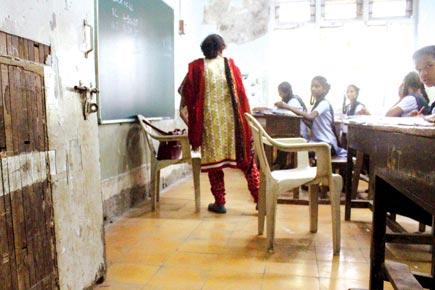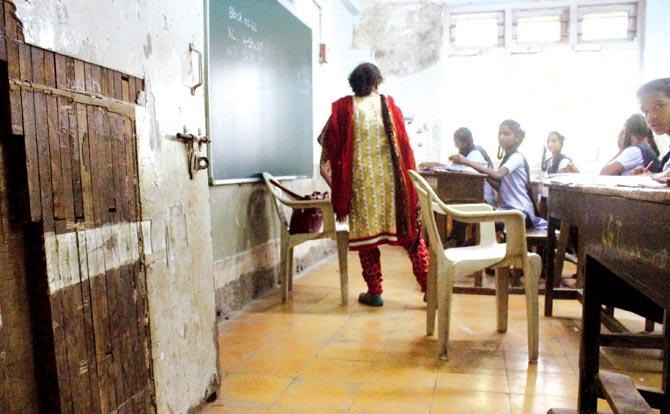The BMC's budgetary allocation for education has risen, but over 30,000 students have dropped out of its schools in past five years

This newspaper recently published a report about the Erangal Marathi Municipal School at Malad that was set up in 1955, but had yet to get fans or lights in its classrooms. File pic for representation
 It's a bad time to be a student at a BMC-run school in Bombay. This shouldn't come as a surprise to most people of this city, of course, because we have all grown up accepting the fact that almost nothing on Earth managed by the BMC has ever been referred to as good. It must be particularly awful this time around though because, according to the non-governmental organisation Praja, more than 30,000 students have dropped out of schools run by that most august of institutions in the past five years.
It's a bad time to be a student at a BMC-run school in Bombay. This shouldn't come as a surprise to most people of this city, of course, because we have all grown up accepting the fact that almost nothing on Earth managed by the BMC has ever been referred to as good. It must be particularly awful this time around though because, according to the non-governmental organisation Praja, more than 30,000 students have dropped out of schools run by that most august of institutions in the past five years.
ADVERTISEMENT

This newspaper recently published a report about the Erangal Marathi Municipal School at Malad that was set up in 1955, but had yet to get fans or lights in its classrooms. File pic for representation
Apparently, there has also been a decline in the number of students seeking admission to these schools. That's not the surprise though. It's how the BMC's budgetary allocation for education has more than doubled in the last five years, according to the same report published earlier this week. Praja says the BMC allocated R1,800 crore for the education of students in 2011-12. The figure for 2015-16 reportedly stands at R2,630 crore. This doesn't seem like a large figure if you keep the number of schools in mind, but it is when you consider that sums as large as these are allocated every year, and have been for decades now. That's a lot of money for something that really doesn't work.
Where does the money go? Your guess is as good as mine. The last time I was at a BMC-run school was during my class 10 examinations, when the wise people who run the Board compelled us all to visit other schools in order to eliminate the possibility of us getting help from our own schools to get us through.
The school I was allocated was in Malvani, a place that has always been mentioned in newspapers around the city for the wrong reasons. This particular school had no fans, because the blades of every one that hadn't been stolen were bent out of shape. The benches were unusable because there had been holes gouged in each of them, presumably by students angry about being forced to sit in classrooms without fans. Most of the lights didn't work either, but a few hundred students like me, from schools around the locality, did our best for 10 days and got through the ordeal. What bothered me back then was how students forced to be at those schools for the rest of the year ever managed to get through a semester. How were they supposed to learn anything?
Two months ago, this newspaper published a report about the Erangal Marathi Municipal School at Malad's Marve beach that had supposedly been waiting for over a decade for some signs of development. Set up in 1955, it had yet to get fans or lights in its classrooms. There was no headmaster and just six teachers to handle 286 students from Std I to X. There was no roof over the toilets and the windows were reportedly kept uncovered. It had just one computer used only by staff and a science laboratory that wasn't used at all. It reminded me almost instantly of the school I visited a few decades ago. Nothing appeared to have changed.
This rant about BMC schools bubbled up inside me for a specific reason. Some corporator recently came up with a proposal to make the Surya Namaskar compulsory in all BMC-run schools. The parties that run the BMC, comprising people who almost never display any signs of having received a decent education, rushed to implement the proposal, compelling over 5.4 lakh students to start their day by contorting their body before attending classes. There may be innumerable benefits to doing a Surya Namaskar, of course, but I failed to understand why they weren't addressing the alarming dropout rate instead.
In September 2015, the BMC decided to haul its students from the dark ages they had been relegated to by introducing a module on sex education. That module was supposed to start a year later, but I have yet to hear about it or how it helps. A couple of months ago, 22,599 tablets were supposedly acquired, of which 22,170 were to be distributed to Class VIII students of civic schools across the city. No one knows why these tablets were selected, how they function or what exactly they do to help students learn anything. A councillor was actually quoted questioning why the tablets were being distributed when the BMC failed to distribute 27 basic items, including textbooks, to students at the beginning of every academic year. Why indeed.
When he isn't ranting about all things Mumbai, Lindsay Pereira can be almost sweet. He tweets @lindsaypereira Send your feedback to mailbag@mid-day.com
 Subscribe today by clicking the link and stay updated with the latest news!" Click here!
Subscribe today by clicking the link and stay updated with the latest news!" Click here!






